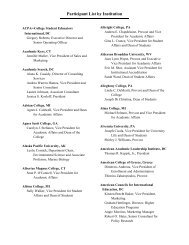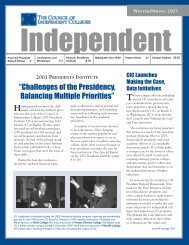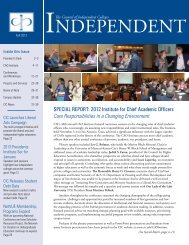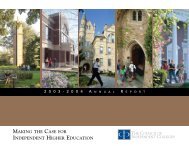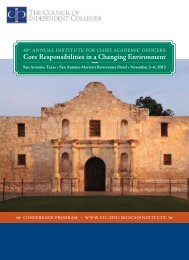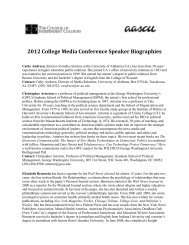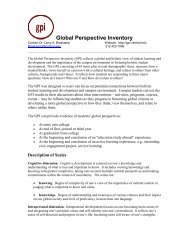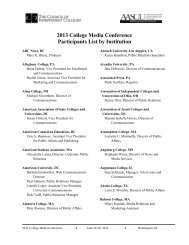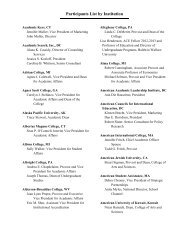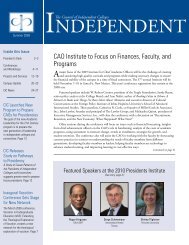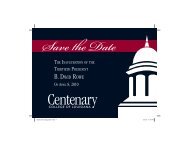Meeting the Challenge: - The Council of Independent Colleges
Meeting the Challenge: - The Council of Independent Colleges
Meeting the Challenge: - The Council of Independent Colleges
Create successful ePaper yourself
Turn your PDF publications into a flip-book with our unique Google optimized e-Paper software.
Small by Design: Resilience in an Era <strong>of</strong> Mass Higher Education<br />
<strong>The</strong> story <strong>of</strong> <strong>the</strong> small liberal arts college in <strong>the</strong> past half century also coincides with<br />
<strong>the</strong> formation and development <strong>of</strong> <strong>the</strong> <strong>Council</strong> <strong>of</strong> <strong>Independent</strong> <strong>Colleges</strong>.<br />
competitors in charting its course and mission. <strong>The</strong> story<br />
<strong>of</strong> <strong>the</strong> independent college is a distinctive saga that has no<br />
counterpart elsewhere in American higher education. Daniel<br />
Webster and his contemporaries—college donors, presidents,<br />
alumni, pr<strong>of</strong>essors, and students—made an effective case for<br />
<strong>the</strong> survival <strong>of</strong> <strong>the</strong> independent liberal arts college in <strong>the</strong> 19 th<br />
century. But how has this institution fared in <strong>the</strong> past halfcentury,<br />
in <strong>the</strong> transition from <strong>the</strong> post-World War II boom<br />
into <strong>the</strong> 21 st century<br />
<strong>The</strong> answer to that question is a story <strong>of</strong> continuous<br />
vitality <strong>of</strong> <strong>the</strong> college in <strong>the</strong> era <strong>of</strong> mass higher education,<br />
even as <strong>the</strong> small liberal arts college increasingly shared <strong>the</strong><br />
higher education stage with relatively younger and usually<br />
larger institutional players: <strong>the</strong> state universities and <strong>the</strong><br />
public two-year junior and community colleges. During<br />
<strong>the</strong> second half <strong>of</strong> <strong>the</strong> 20 th century, all <strong>of</strong> American higher<br />
education was transformed by important public policies at<br />
<strong>the</strong> federal and state levels.<br />
Faced with a fluid landscape <strong>of</strong> higher education<br />
systems, especially in <strong>the</strong> public sector, independent liberal<br />
arts colleges have been highly effective in maintaining and<br />
revitalizing <strong>the</strong>ir mission <strong>of</strong> baccalaureate education. <strong>The</strong>ir<br />
resilience has required innovation in <strong>the</strong> curriculum and<br />
<strong>the</strong> structure <strong>of</strong> <strong>the</strong>ir campuses and has alerted attention<br />
to changes in <strong>the</strong> external environment <strong>of</strong> state and federal<br />
policies as well as in private philanthropy. <strong>The</strong> story <strong>of</strong> <strong>the</strong><br />
small liberal arts college in <strong>the</strong> past half century also coincides<br />
with <strong>the</strong> formation and development <strong>of</strong> <strong>the</strong> <strong>Council</strong> <strong>of</strong><br />
<strong>Independent</strong> <strong>Colleges</strong>.<br />
<strong>The</strong> Paradox <strong>of</strong><br />
Quantity and Quality<br />
Reconstructing <strong>the</strong> story <strong>of</strong> independent liberal arts<br />
colleges over <strong>the</strong> past half century is like traveling with Alice<br />
through <strong>the</strong> looking glass. Like Alice’s trip to Wonderland, <strong>the</strong><br />
path is marked by puzzles—most <strong>of</strong> which eventually make<br />
sense, but only after some thoughtful sorting and sifting.<br />
For example, <strong>the</strong> curious situation <strong>of</strong> <strong>the</strong><br />
independent colleges was that <strong>the</strong>y grew smaller while <strong>the</strong>y<br />
grew larger. How could it be <strong>The</strong> number <strong>of</strong> four-year<br />
independent liberal arts colleges increased after World War<br />
II. Most <strong>of</strong> <strong>the</strong>m also increased in size by expanding <strong>the</strong>ir<br />
enrollments, admitting more students between 1950 and<br />
2005 than ever before; indeed, enrollment at independent<br />
four-year institutions more than doubled in this period.<br />
However, absolute growth coincided with a relative decline as<br />
a proportion <strong>of</strong> all American institutions <strong>of</strong> higher education.<br />
<strong>The</strong> liberal arts colleges came to represent a smaller<br />
percentage <strong>of</strong> American institutions and undergraduate<br />
4



